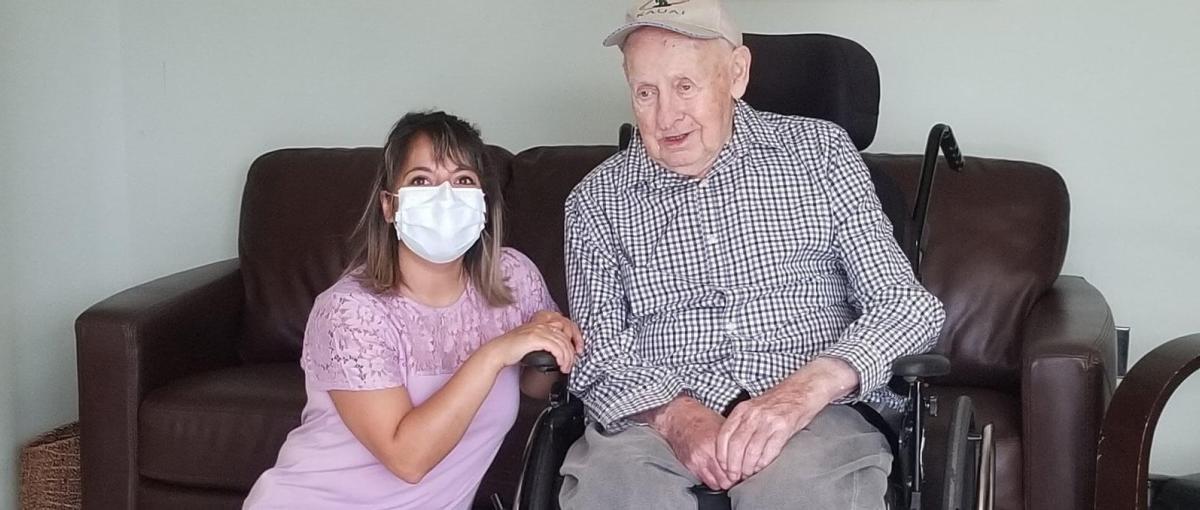Finding the right fit
Virtual assessment sizes up resident for new wheelchair

July 27, 2020
By Brenton Driedger, Social Media and Storytelling Advisor, Covenant Health
Occupational therapist Sheren Cherri is used to travelling to different rural sites to provide services in person, but COVID-19 has required her to get creative.
Sheren splits her time between Mary Immaculate Care Centre in Mundare and the High Prairie Health Complex. Recently, she wasn’t able to do an on-site assessment for one of her Mundare residents, 91-year-old Guenter Bork, who needed to be fitted for a new wheelchair. So she began to explore how she could provide her services virtually and arranged for a virtual assessment with her therapy assistant holding a tablet.
“I could see if he was leaning to the right or if he was slumped forward — if his pelvis wasn’t neutral. I could see his facial expression: was he happy, was he comfortable,” says Sheren. “I was trying to assess as much as I could as if I was there.”
Sheren took the virtual approach after discussing it with Melissa Sztym, occupational therapy professional practice lead for Covenant Health and team lead for the stroke early supported discharge program at St. Mary’s Hospital in Camrose. The Camrose stroke team regularly uses virtual appointments to support patients. Melissa shared resources and insight from the team's experience as well as research that supports virtual care.
“There’s great evidence emerging that virtual service provision can be as good as in-person care,” says Melissa. That includes a recent Canadian Medical Association poll showing that nearly half of Canadians have accessed a physician using virtual care options. And those who have connected with a doctor virtually during COVID-19 report a 91 per cent satisfaction rate.
After Sheren and the therapy assistant in Mundare, Leida Caspers, assessed Guenter, they decided a new tilt wheelchair would be the best option for him. They arranged for a trial wheelchair to be delivered to the site and set up another virtual session so they could see how it fit. They observed his facial expressions, examined how his pelvis was sitting and gathered feedback from other care staff. With Sheren guiding her, Leida took various measurements to see how the chair fit Guenter’s hips, back and sides.
“I saw how he was sitting in the tilt wheelchair. I could see if the size was appropriate,” says Sheren.
Sheren also asked Guenter’s wife, Susan, to take a look at the wheelchair through the glass doors the next time she came to visit.
“It looked good to me,” says Susan. “He’s sitting straight, and he acts quite happy. I am happy with the way that it turned out.”
Sheren used the feedback from Susan and the care team as well as Leida’s measurements to order Guenter’s custom wheelchair.
“That site really supported Sheren,” says Melissa. “They were responsive and were able to use the technology quickly. It’s a steep learning curve, and they did a really good job of quick uptake of virtual technology to be able to support and be timely and responsive to client need during the COVID response.”
Sheren is used to using muscle memory to take all the measurements, so doing a virtual assessment was a challenge. In this case, she had to carefully think through each aspect of the assessment and discuss what she wanted with her assistant.
“Communication was super important, for me to be clear and specific.”
Melissa says finding new ways of doing things could be a silver lining to the challenges of COVID-19.
“We’ve had to really think outside the box. We’ve had to be creative. And I think all these examples show us, as clinicians, how creative and innovative we can be to provide services and ensure that our clients are getting the right service at the right time, regardless of whether it’s a geographical barrier or if it’s a pandemic and we can’t be face to face with our clients and residents.”
Sheli Murphy, senior operating officer for rural health services, believes virtual care is the way of the future. It allows care experts to spend more time providing care and sharing expertise with patients, residents and staff and less time travelling. She says rural sites are looking at potential virtual options for everything from ambulatory care clinics to lab services and healthcare simulations.
“I don’t want to presume that we would do everything this way, but I think there’s a high percentage that could be done this way, which would create a lot more efficiencies in the system while still maintaining the balance of having those personal moments for staff getting together, building relationships on a site and building relationships with residents.”
“When people take an old way of doing something and do it in a new way and, at the end, the people that we’re serving win and the system wins, that’s innovation,” says Sheli.
Sheren says she enjoyed collaborating virtually with Mundare staff. Some of them would see Leida with the iPad as she was preparing to do an assessment, and they would stop by to say hi to Sheren.
“They were all very co-operative, very supportive, and everyone there loves the residents. So it was very easy to get everyone on board knowing that I was working from home virtually.”